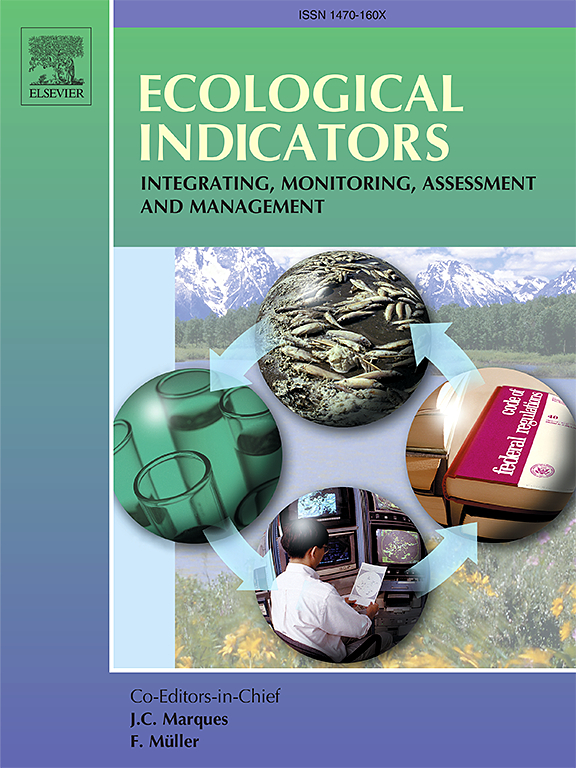Spatiotemporal evolution of ecosystem health and its driving factors in the southwestern karst regions of China
IF 7
2区 环境科学与生态学
Q1 ENVIRONMENTAL SCIENCES
引用次数: 0
Abstract
As one of the most typical karst landscapes globally, the karst regions in southwestern China are characterized by prominent rocky desertification and fragile ecological conditions. Consequently, exploring the spatiotemporal evolution and driving influences on ecosystem health (EH) in this region is of great significance for the improvement of ecosystems and green development. This study focuses on assessing EH in these regions from 2000 to 2020 using the “vitality-organization-recovery-service” (VORS) framework. Spatiotemporal changes in EH are analyzed through hotspot analysis, and the functional relationship between driving factors and EH is quantified using XGBoost and SHAP models. Key findings include: (1) Over the past two decades, the proportion of cities experiencing enhanced EH has generally improved in 73% of cities compared to 27% experiencing deterioration. (2) Spatial analysis reveals EH clustering in three regions. One cold spot cluster in the central north and two hot spot clusters in the southwest and southeast. (3) Urbanization level exhibits an inverse logarithmic relationship with EH. Precipitation affects EH in a cubic polynomial pattern—initial decrease, subsequent increase, and final decrease. Temperature impacts EH through a quartic polynomial function with fluctuating increases and decreases. PM2.5 shows a monotonically decreasing relationship with EH, while the normalized difference vegetation index demonstrates a monotonically increasing association. This research contributes to understanding EH dynamics in southwestern China’s karst landscapes, crucial for advancing ecosystem management and sustainable development efforts.中国西南岩溶地区生态系统健康的时空演变及其驱动因素
作为全球最典型的喀斯特地貌之一,中国西南喀斯特地区石漠化突出、生态脆弱。因此,探索该地区生态系统健康(EH)的时空演变及其驱动影响因素,对改善生态系统和实现绿色发展具有重要意义。本研究采用 "活力-组织-恢复-服务"(VORS)框架,重点评估这些地区 2000 年至 2020 年的生态系统健康状况。通过热点分析对 EH 的时空变化进行了分析,并利用 XGBoost 和 SHAP 模型量化了驱动因素与 EH 之间的函数关系。主要发现包括(1) 在过去 20 年中,73% 的城市环境健康状况得到改善,27% 的城市环境健康状况恶化。(2)空间分析表明,环境健康状况在三个地区出现了聚集。一个冷点集群位于中北部,两个热点集群分别位于西南部和东南部。(3) 城市化水平与 EH 呈反对数关系。降水对 EH 的影响呈立方多项式模式--最初减少,随后增加,最后减少。温度对 EH 的影响呈波动增减的四次多项式关系。PM2.5 与 EH 呈单调递减关系,而归一化差异植被指数则呈单调递增关系。这项研究有助于了解中国西南喀斯特地貌的 EH 动态,对推进生态系统管理和可持续发展至关重要。
本文章由计算机程序翻译,如有差异,请以英文原文为准。
求助全文
约1分钟内获得全文
求助全文
来源期刊

Ecological Indicators
环境科学-环境科学
CiteScore
11.80
自引率
8.70%
发文量
1163
审稿时长
78 days
期刊介绍:
The ultimate aim of Ecological Indicators is to integrate the monitoring and assessment of ecological and environmental indicators with management practices. The journal provides a forum for the discussion of the applied scientific development and review of traditional indicator approaches as well as for theoretical, modelling and quantitative applications such as index development. Research into the following areas will be published.
• All aspects of ecological and environmental indicators and indices.
• New indicators, and new approaches and methods for indicator development, testing and use.
• Development and modelling of indices, e.g. application of indicator suites across multiple scales and resources.
• Analysis and research of resource, system- and scale-specific indicators.
• Methods for integration of social and other valuation metrics for the production of scientifically rigorous and politically-relevant assessments using indicator-based monitoring and assessment programs.
• How research indicators can be transformed into direct application for management purposes.
• Broader assessment objectives and methods, e.g. biodiversity, biological integrity, and sustainability, through the use of indicators.
• Resource-specific indicators such as landscape, agroecosystems, forests, wetlands, etc.
文献相关原料
| 公司名称 | 产品信息 | 采购帮参考价格 |
|---|
 求助内容:
求助内容: 应助结果提醒方式:
应助结果提醒方式:


